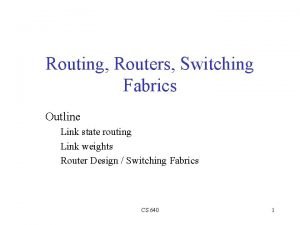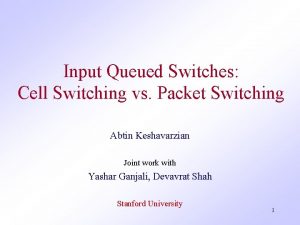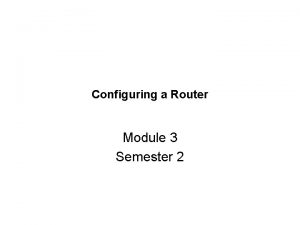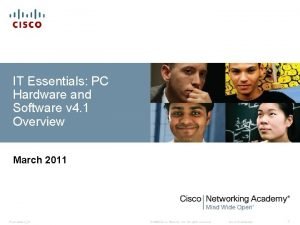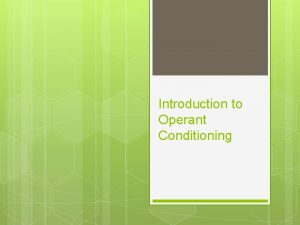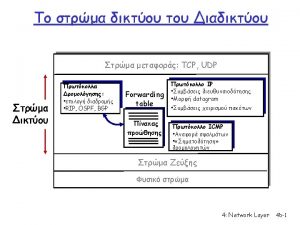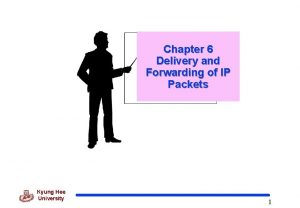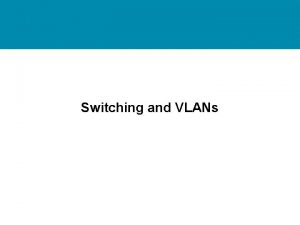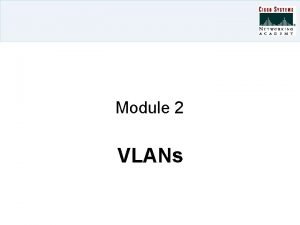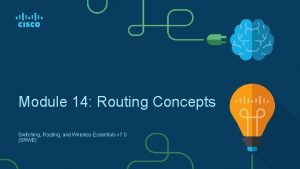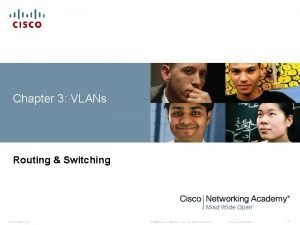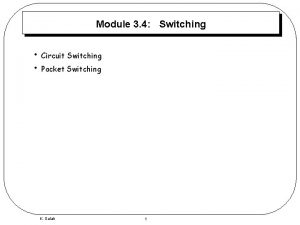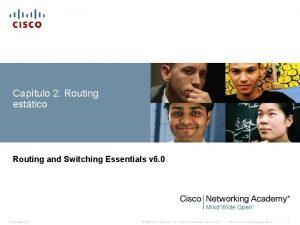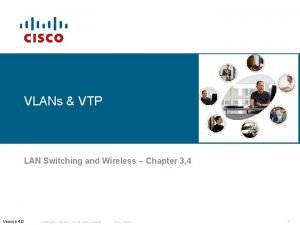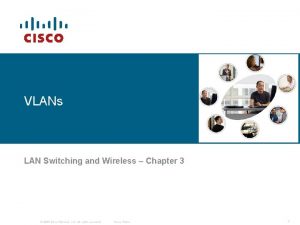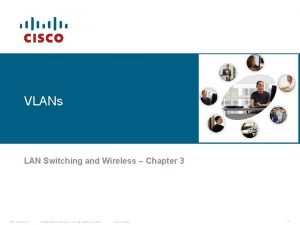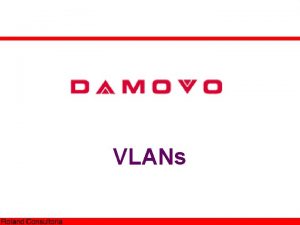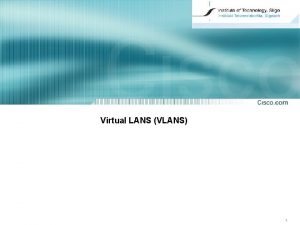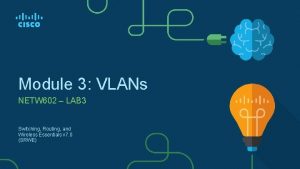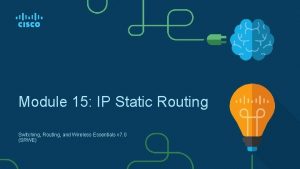Module 3 VLANs Switching Routing and Wireless Essentials







































- Slides: 39

Module 3: VLANs Switching, Routing, and Wireless Essentials v 7. 0 (SRWE)

3. 1 Overview of VLANs © 2016 Cisco and/or its affiliates. All rights reserved. Cisco Confidential 2

Overview of VLANs VLAN Definitions VLANs are logical connections with other similar devices. Placing devices into various VLANs have the following characteristics: • Provides segmentation of the various groups of devices on the same switches • Provide organization that is more manageable • Broadcasts, multicasts and unicasts are isolated in the individual VLAN • Each VLAN must have its own unique range of IP addressing • Smaller broadcast domains © 2016 Cisco and/or its affiliates. All rights reserved. Cisco Confidential 3

Overview of VLANs Benefits of a VLAN Design Benefits of using VLANs are as follows: Benefits Description Smaller Broadcast Domains Dividing the LAN reduces the number of broadcast domains Improved Security Only users in the same VLAN can communicate together Improved IT Efficiency VLANs can group devices with similar requirements, e. g. faculty vs. students Reduced Cost One switch can support multiple groups or VLANs Better Performance Small broadcast domains reduce traffic, improving bandwidth Simpler Management Similar groups will need similar applications and other network resources © 2016 Cisco and/or its affiliates. All rights reserved. Cisco Confidential 4

Overview of VLANs Types of VLANs VLAN 1 is the following: • The default VLAN • The default Native VLAN • The default Management VLAN • Cannot be deleted or renamed Note: While we cannot delete VLAN 1 Cisco recommends that we assign these default features to other VLANs © 2016 Cisco and/or its affiliates. All rights reserved. Cisco Confidential 5

Overview of VLANs Types of VLANs (Cont. ) Data VLAN • Dedicated to user-generated traffic (email, web traffic, etc). • VLAN 1 is the default data VLAN because all interfaces are assigned to this VLAN. Native VLAN • This is used for trunk links only. • All frames are tagged on an 802. 1 Q trunk link except for those on the native VLAN. Management VLAN • This is used for SSH/Telnet VTY traffic and should not be carried with end user traffic. • Typically, this VLAN is the SVI for the Layer 2 switch. © 2016 Cisco and/or its affiliates. All rights reserved. Cisco Confidential 6

Overview of VLANs Types of VLANs (Cont. ) Voice VLAN • A separate VLAN is required because Voice traffic requires: • Assured bandwidth • High Qo. S priority • Ability to avoid congestion • Delay less that 150 ms from source to destination • The entire network must be designed to support voice. © 2016 Cisco and/or its affiliates. All rights reserved. Cisco Confidential 7

3. 2 VLANs in a Multi-Switched Environment © 2016 Cisco and/or its affiliates. All rights reserved. Cisco Confidential 8

VLANs in a Multi-Switched Environment Defining VLAN Trunks A trunk is a point-to-point link between two network devices. Cisco trunk functions: • Allow more than one VLAN • Extend the VLAN across the entire network • By default, supports all VLANs • Supports 802. 1 Q encapsulation © 2016 Cisco and/or its affiliates. All rights reserved. Cisco Confidential 9

VLANs in a Multi-Switched Environment Networks without VLANs Without VLANs, all devices connected to the switches will receive all unicast, multicast, and broadcast traffic. © 2016 Cisco and/or its affiliates. All rights reserved. Cisco Confidential 10

VLANs in a Multi-Switched Environment Networks with VLANs With VLANs, unicast, multicast, and broadcast traffic is confined to a VLAN. Without a Layer 3 device to connect the VLANs, devices in different VLANs cannot communicate. © 2016 Cisco and/or its affiliates. All rights reserved. Cisco Confidential 11

VLANs in a Multi-Switched Environment VLAN Identification with a Tag • The IEEE 802. 1 Q header is 4 Bytes • When the tag is created the FCS must be recalculated. • When sent to end devices, this tag must be removed and the FCS recalculated back to its original number. 802. 1 Q VLAN Tag Field Function Type • • 2 -Byte field with hexadecimal 0 x 8100 This is referred to as Tag Protocol ID (TPID) User Priority • 3 -bit value that supports Canonical Format Identifier (CFI) • 1 -bit value that can support token ring frames on Ethernet VLAN ID (VID) • 12 -bit VLAN identifier that can support up to 4096 VLANs © 2016 Cisco and/or its affiliates. All rights reserved. Cisco Confidential 12

VLANs in a Multi-Switched Environment Native VLANs and 802. 1 Q Tagging 802. 1 Q trunk basics: • Tagging is typically done on all VLANs. • The use of a native VLAN was designed for legacy use, like the hub in the example. • Unless changed, VLAN 1 is the native VLAN. • Both ends of a trunk link must be configured with the same native VLAN. • Each trunk is configured separately, so it is possible to have a different native VLANs on separate trunks. © 2016 Cisco and/or its affiliates. All rights reserved. Cisco Confidential 13

VLANs in a Multi-Switched Environment Voice VLAN Tagging The Vo. IP phone has a three-port switch: • The switch will use CDP to inform the phone of the Voice VLAN. • The phone will tag its own traffic (Voice) and can set Cost of Service (Co. S). Co. S is Qo. S for layer 2. • The phone may or may not tag frames from the PC. Traffic Tagging Function Voice VLAN tagged with an appropriate Layer 2 class of service (Co. S) priority value Access VLAN can also be tagged with a Layer 2 Co. S priority value Access VLAN is not tagged (no Layer 2 Co. S priority value) © 2016 Cisco and/or its affiliates. All rights reserved. Cisco Confidential 14

VLANs in a Multi-Switched Environment Voice VLAN Verification Example The show interfaces fa 0/18 switchport command can show us both data and voice VLANs assigned to the interface. © 2016 Cisco and/or its affiliates. All rights reserved. Cisco Confidential 15

3. 3 VLAN Configuration © 2016 Cisco and/or its affiliates. All rights reserved. Cisco Confidential 16

VLAN Configuration VLAN Ranges on Catalyst Switches Catalyst switches 2960 and 3650 support over 4000 VLANs. Normal Range VLAN 1 – 1005 Extended Range VLAN 1006 - 4095 Used in Small to Medium sized businesses Used by Service Providers 1002 – 1005 are reserved for legacy VLANs Are in Running-Config 1, 1002 – 1005 are auto created and cannot be Supports fewer VLAN features deleted Stored in the vlan. dat file in flash Requires VTP configurations VTP can synchronize between switches © 2016 Cisco and/or its affiliates. All rights reserved. Cisco Confidential 17

VLAN Configuration VLAN Creation Commands VLAN details are stored in the vlan. dat file. You create VLANs in the global configuration mode. Task IOS Command Enter global configuration mode. Switch# configure terminal Create a VLAN with a valid ID number. Switch(config)# vlan-id Specify a unique name to identify the VLAN. Switch(config-vlan)# name vlan-name Return to the privileged EXEC mode. Switch(config-vlan)# end © 2016 Cisco and/or its affiliates. All rights reserved. Cisco Confidential 18

VLAN Configuration VLAN Creation Example • If the Student PC is going to be in VLAN 20, we will create the VLAN first and then name it. • If you do not name it, the Cisco IOS will give it a default name of vlan and the four-digit number of the VLAN. E. g. VLAN 0020 for VLAN 20. Prompt Command S 1# configure terminal S 1(config)# vlan 20 S 1(config-vlan)# name STUDENT S 1(config-vlan)# end © 2016 Cisco and/or its affiliates. All rights reserved. Cisco Confidential 19

VLAN Configuration VLAN Port Assignment Commands Once the VLAN is created, we can then assign it to the correct interfaces. Task Command Enter global configuration mode. Switch# configure terminal Enter interface configuration mode. Switch(config)# interface-id Set the port to access mode. Switch(config-if)# switchport mode access Assign the port to a VLAN. Switch(config-if)# switchport access vlan-id Return to the privileged EXEC mode. Switch(config-if)# end © 2016 Cisco and/or its affiliates. All rights reserved. Cisco Confidential 20

VLAN Configuration VLAN Port Assignment Example We can assign the VLAN to the port interface. • Once the device is assigned the VLAN, then the end device will need the IP address information for that VLAN • Here, Student PC uses 172. 17. 20. 22 Prompt Command S 1# configure terminal S 1(config)# interface fa 0/18 S 1(config-if)# switchport mode access S 1(config-if)# switchport access vlan 20 S 1(config-if)# end © 2016 Cisco and/or its affiliates. All rights reserved. Cisco Confidential 21

VLAN Configuration Data and Voice VLANs An access port may only be assigned to one data VLAN. However it may also be assigned to a Voice VLAN when a phone and an end device are connected through the same switchport. © 2016 Cisco and/or its affiliates. All rights reserved. Cisco Confidential 22

VLAN Configuration Data and Voice VLAN Example • We will want to create and name both Voice and Data VLANs. • In addition to assigning the data VLAN, we will also assign the Voice VLAN and turn on Qo. S for the voice traffic to the interface. • The newer catalyst switches automatically create the VLAN, if it does not already exist, when the VLAN is assigned to an interface. Note: Qo. S is beyond the scope of this course. Here we show the use of the mls qos trust [cos | device cisco-phone | dscp | ipprecedence] command. © 2016 Cisco and/or its affiliates. All rights reserved. Cisco Confidential 23

VLAN Configuration Verify VLAN Information Use the show vlan command. The complete syntax is: show vlan [brief | id vlan-id | name vlan-name | summary] Task Command Option Display VLAN name, status, and its ports one VLAN per line. brief Display information about the identified VLAN ID number. id vlan-id Display information about the identified VLAN name. The vlan-name is an ASCII string from 1 to 32 characters. name vlan-name Display VLAN summary information. summary © 2016 Cisco and/or its affiliates. All rights reserved. Cisco Confidential 24

VLAN Configuration Change VLAN Port Membership There are two ways to change VLAN membership on an interface: • re-enter switchport access vlan-id command • use the no switchport access vlan to place the interface back in VLAN 1 Use the show vlan brief or the show interface fa 0/18 switchport commands to verify the correct VLAN association. © 2016 Cisco and/or its affiliates. All rights reserved. Cisco Confidential 25

VLAN Configuration Delete VLANs with the no vlan-id command. Caution: Before deleting a VLAN, reassign all member ports to a different VLAN. • Delete all VLANs with the delete flash: vlan. dat or delete vlan. dat commands. • Reload the switch when deleting all VLANs. Note: To restore to factory default – unplug all data cables, erase the startup-configuration, delete the vlan. dat file, then reload the device. © 2016 Cisco and/or its affiliates. All rights reserved. Cisco Confidential 26

VLAN Configuration VLAN Trunking Protocol (VTP) VLAN Trunking Protocol is a Cisco proprietary protocol to propagate VLAN numbers and names across multiple switches in the LAN. While this may seem like a good idea, it poses security risks and should be disabled. This command should be used in global configuration: SW 1(config)# vtp mode transparent An additional benefit of using this command is that VLAN configurations will now appear in the show running-config output making configurations easier to copy and document. © 2016 Cisco and/or its affiliates. All rights reserved. Cisco Confidential 27

3. 4 VLAN Trunks © 2016 Cisco and/or its affiliates. All rights reserved. Cisco Confidential 28

VLAN Trunks Trunk Configuration Commands Configure and verify VLAN trunks. Trunks are layer 2 and by default carry traffic for all VLANs. Task IOS Command Enter global configuration mode. Switch# configure terminal Enter interface configuration mode. Switch(config)# interface-id Set the port to permanent trunking mode. Switch(config-if)# switchport mode trunk Sets the native VLAN to something other than VLAN 1. Switch(config-if)# switchport trunk native vlan-id Specify the list of VLANs to be allowed on the trunk link. Switch(config-if)# switchport trunk allowed vlan-list Return to the privileged EXEC mode. Switch(config-if)# end © 2016 Cisco and/or its affiliates. All rights reserved. Cisco Confidential 29

VLAN Trunks Trunk Configuration Example The subnets associated with each VLAN are: • VLAN 10 - Faculty/Staff - 172. 17. 10. 0/24 • VLAN 20 - Students - 172. 17. 20. 0/24 • VLAN 30 - Guests - 172. 17. 30. 0/24 • VLAN 99 - Native - 172. 17. 99. 0/24 F 0/1 port on S 1 is configured as a trunk port. Prompt Command S 1(config)# interface fa 0/1 Note: This assumes a 2960 switch using 802. 1 Q tagging. Layer 3 switches require the encapsulation to be configured before the trunk mode. S 1(config-if)# switchport mode trunk S 1(config-if)# switchport trunk native vlan 99 S 1(config-if)# switchport trunk allowed vlan 1, 10, 20, 30, 99 S 1(config-if)# end © 2016 Cisco and/or its affiliates. All rights reserved. Cisco Confidential 30

VLAN Trunks Verify Trunk Configuration Set the trunk mode and native vlan. See the output from the show interfaces fa 0/1 switchport command: • Is set to trunk administratively • Is set as trunk operationally (functioning) • Encapsulation is dot 1 q • Native VLAN set to VLAN 99 • All VLANs created on the switch will pass traffic on this trunk © 2016 Cisco and/or its affiliates. All rights reserved. Cisco Confidential 31

VLAN Trunks Reset the Trunk to the Default State • Reset the default trunk settings with the no command. • All VLANs allowed to pass traffic • Native VLAN = VLAN 1 • Verify the default settings with a sh int fa 0/1 switchport command. © 2016 Cisco and/or its affiliates. All rights reserved. Cisco Confidential 32

VLAN Trunks Reset the Trunk to the Default State (Cont. ) Reset the trunk to access mode with the switchport mode access command: • Is set to an access interface administratively • Is set as an access interface operationally (functioning) © 2016 Cisco and/or its affiliates. All rights reserved. Cisco Confidential 33

3. 5 Dynamic Trunking Protocol © 2016 Cisco and/or its affiliates. All rights reserved. Cisco Confidential 34

Dynamic Trunking Protocol Introduction to DTP Dynamic Trunking Protocol (DTP) is a proprietary Cisco protocol. DTP characteristics are as follows: • On by default on Catalyst 2960 and 3650 switches • Dynamic-auto is default on the 2960 and 3650 switches • May be turned off with the nonegotiate command • May be turned back on by setting the interface to dynamic-auto • Setting a switch to a static trunk or static access will avoid negotiation issues with the switchport mode trunk or the switchport mode access commands. © 2016 Cisco and/or its affiliates. All rights reserved. Cisco Confidential 35

Dynamic Trunking Protocol Negotiated Interface Modes Use the switchport nonegotiate interface configuration command to stop DTP negotiation. The switchport mode command has additional options: Option Description access Permanent access mode and negotiates to convert the neighboring link into an access link dynamic auto Will becomes a trunk interface if the neighboring interface is set to trunk or desirable mode dynamic desirable Actively seeks to become a trunk by negotiating with other auto or desirable interfaces trunk Permanent trunking mode and negotiates to convert the neighboring link into a trunk link © 2016 Cisco and/or its affiliates. All rights reserved. Cisco Confidential 36

Dynamic Trunking Protocol Results of a DTP Configuration DTP configuration options are as follows: Dynamic Auto Dynamic Desirable Trunk Access Dynamic Auto Access Trunk Access Dynamic Desirable Trunk Access Trunk Limited connectivity Access Limited connectivity Access © 2016 Cisco and/or its affiliates. All rights reserved. Cisco Confidential 37

Dynamic Trunking Protocol Verify DTP Mode The default DTP configuration is dependent on the Cisco IOS version and platform. § Use the show dtp interface command to determine the current DTP mode. § Best practice recommends that the interfaces be set to access or trunk and to disable DTP with the nonegotiate command. © 2016 Cisco and/or its affiliates. All rights reserved. Cisco Confidential 38

 Circuit switching vs packet switching vs message switching
Circuit switching vs packet switching vs message switching Differentiate between virtual circuit and datagram network
Differentiate between virtual circuit and datagram network Packet switched network vs circuit switched network
Packet switched network vs circuit switched network Routing and switching protocols
Routing and switching protocols Hong kong university
Hong kong university 325181028 routing
325181028 routing Routing and switching protocols
Routing and switching protocols Cell switching vs packet switching
Cell switching vs packet switching Packet switching system
Packet switching system Cell switching vs packet switching
Cell switching vs packet switching Lan switching and wireless
Lan switching and wireless Which layer of the osi model includes vlans?
Which layer of the osi model includes vlans? Introduction to vlans
Introduction to vlans River routing and reservoir routing
River routing and reservoir routing Mark tinka
Mark tinka Hydrologic routing and hydraulic routing
Hydrologic routing and hydraulic routing Comparison of clock routing and power routing
Comparison of clock routing and power routing Routing switching adalah
Routing switching adalah Telecommunications the internet and wireless technology
Telecommunications the internet and wireless technology Microsoft wireless router module
Microsoft wireless router module C device module module 1
C device module module 1 What is linguistic repertoire
What is linguistic repertoire Insulation coordination in high voltage engineering
Insulation coordination in high voltage engineering Optical switching and networking
Optical switching and networking Advantages and disadvantages of wired and wireless networks
Advantages and disadvantages of wired and wireless networks Safeguarding and child protection the essentials
Safeguarding and child protection the essentials Cisco it essentials virtual desktop
Cisco it essentials virtual desktop Essentials of business and online commerce law
Essentials of business and online commerce law Name and define the four narrative essentials of a play
Name and define the four narrative essentials of a play Essentials of nursing leadership and management
Essentials of nursing leadership and management Web essentials clients servers and communication
Web essentials clients servers and communication Essentials of systems analysis and design
Essentials of systems analysis and design Baygeldi atayev
Baygeldi atayev It essentials pc hardware and software
It essentials pc hardware and software Graphic design essentials
Graphic design essentials Operant conditioning definition
Operant conditioning definition It essentials pc hardware and software
It essentials pc hardware and software Ortec routing and dispatch
Ortec routing and dispatch Interplay between routing and forwarding
Interplay between routing and forwarding Delivery and routing of ip packets
Delivery and routing of ip packets



